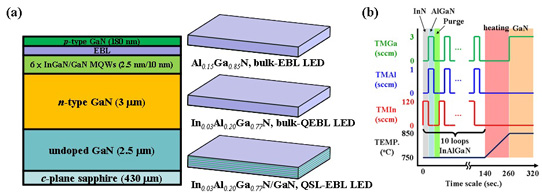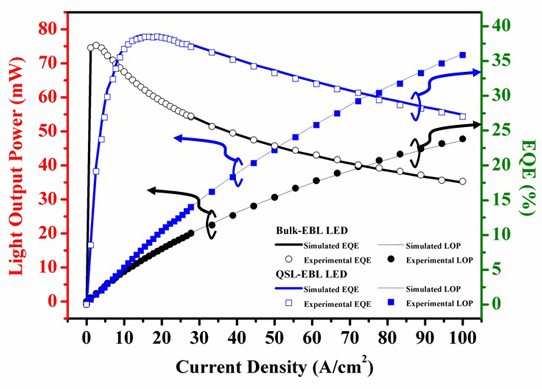- News
30 May 2016
Quaternary superlattice for III-nitride electron-blocking layers
Researchers in Taiwan have implemented a quaternary superlattice (QSL) indium aluminium gallium nitride (InAlGaN) electron-blocking layer (EBL) to improve light output power and external quantum efficiency (EQE) of green light-emitting diodes (LEDs) [An-Jye Tzou et al, Optics Express, Vol. 24, p11387, 2016].
Efficient high-brightness LEDs are difficult to achieve in the green wavelength range. Filling the 'green gap' is expected to improve color rendering for energy-efficient white light applications.
EBLs are used to confine electrons to the active multiple quantum well (MQW) light-emitting region rather than allowing them to enter into the p-GaN contact where electron-hole recombination is generally non-radiative. However, EBLs can also raise barriers for hole injection into the MQW, reducing efficiency.
Conventional LEDs use bulk ternary AlGaN as EBL. Adding a fourth element (indium) gives more flexibility in terms of strain compensation. Strain in III-nitride heterostructures gives rise to electric fields due to the charge polarization of the partially ionic chemical bonds. Electric fields in the MQW pull electrons and holes apart, reducing their recombination into photons – a phenomenon that goes under the title of quantum-confined Stark effect (QCSE).
The team from National Chiao Tung University, Epistar, and Academia Sinica, explains: "The QSL-EBL structure can reduce the polarization-related electrostatic fields in the MQWs, leading to a smoother band diagram and a more uniform carrier distribution among the quantum wells under forward bias."

Figure 1: Schematics of LED structure with ternary and quaternary (QEBL) bulk-EBLs, and QSL-EBL. (b) Growth sequence for InAlGaN QSL-EBL.
Low-pressure metal-organic chemical vapor deposition (MOCVD) in a vertical reactor was used to create the LED epitaxial material on sapphire (Figure 1). A layer of AlN was sputtered on the sapphire for nucleating the MOCVD growth. The MQWs consisted of In0.27Ga0.73N.
Two different EBL structures were produced: a conventional ternary 20nm bulk p-Al0.15Ga0.85N layer, and a QSL consisting of five 2nm p-GaN wells and six 2nm p-In0.03Al0.20Ga0.77N barriers. The researchers also simulated a bulk quaternary EBL consisting of a 20nm p- In0.03Al0.20Ga0.77N layer.
One can speculate as to the reason for not attempting to grow such a bulk quaternary InAlGaN layer (e.g. strain/stability problems in thick layers?). In any case, the simulation suggests that it would perform worse than the QSL structure due to the generation of strong electrostatic fields in the last well of the MQW, leading to reduced radiative recombination from a smaller overlap of the electron and hole wavefunctions. A similar problem is seen in the structure with a bulk ternary AlGaN EBL.
The simulations also suggest that the QSL EBL has a higher barrier to electron overflow combined with a lower barrier to hole injection into the MQW than either bulk EBL. The QSL electron barrier is estimated at 306meV, compared with 231meV and 260meV for the ternary and quaternary bulk EBLs, respectively. The hole barriers were 210meV for the QSL, and 244meV/215meV for the respective ternary/quaternary bulk EBLs.
The researchers comment: "This result is attributed to polarization-matched QSL-EBL regarding the raised electrostatic field at the interface between the last barrier and EBL. This improvement suggests that the lower negative electrostatic field in InAlGaN of QSL-EBL than in bulk-QEBL and bulk-EBL. Therefore, the QSL-EBL not only suppressed the electron overflow but also improved the hole injection efficiency."
The quaternary material was grown by a digital method where 4 seconds of InN growth was alternated with 4 seconds of AlGaN. The 2nm layer took 10 cycles/loops of InN/AlGaN deposition. There was a six second hydrogen purge between AlGaN and InN depositions to enhance migration of the aluminium adatoms. The quaternary growth temperature was 750°C. The GaN barriers were grown at 850°C.
Mesa LEDs were fabricated with a 300μmx300μm indium tin oxide (ITO) transparent current-spreading layer on the p-GaN contact layer, and nickel/gold as electrodes for both contacts. The emission wavelength was around 550nm, at the long yellow end of the green range of 495nm-570nm.
The light output power and external quantum efficiency (EQE) were improved for the LED QSL EBL compared with the ternary AlGaN bulk EBL (Figure 2). The EQE at 100A/cm2 injection was 53% better for the QSL EBL LED than for the AlGaN EBL. The peak efficiency for the QSL EBL device was at 17A/cm2 and was higher than the AlGaN EBL peak, which occurred at a couple of A/cm2. The droop at 100A/cm2 from the peak was 30% for the QSL LED and 52% for the bulk AlGaN EBL. Often smaller droop is achieved at the expense of peak efficiency, unlike in this case.

Figure 2: Measured light output power and EQE curves as function of injection current density for LEDs. Experimental EQE and power data plotted as symbols are well fitted to simulation lines.
The researchers comment that the droop was consistent with their simulations, attributing the improvement to enhanced hole injection and electron confinement, adding "polarization matched QSL-EBL is a good solution for high-efficiency InGaN-based green LEDs".
Quaternary superlattice InAlGaN EBL Green LEDs Efficiency droop
http://dx.doi.org/10.1364/OE.24.011387
The author Mike Cooke is a freelance technology journalist who has worked in the semiconductor and advanced technology sectors since 1997.


